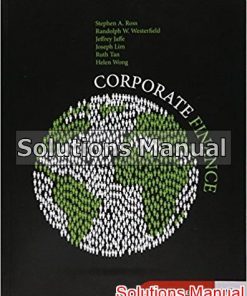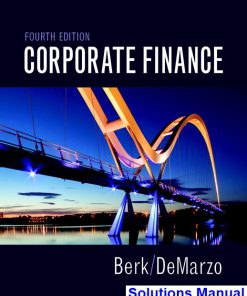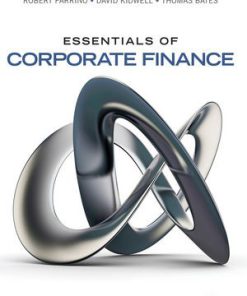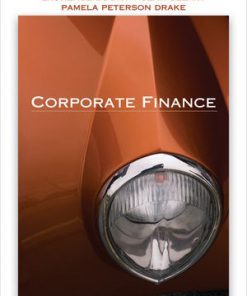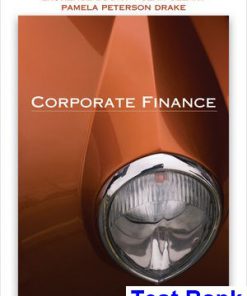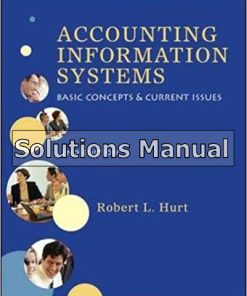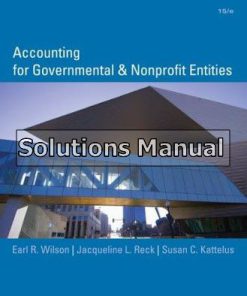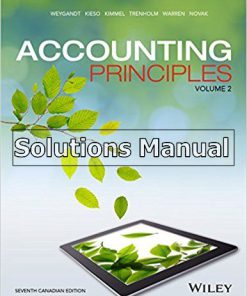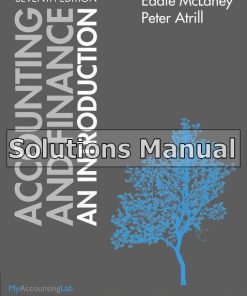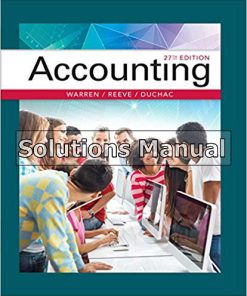NEW Corporate Finance Online 1st Edition Eakins Solutions Manual
$26.50$50.00 (-47%)
NEW Corporate Finance Online 1st Edition Eakins Solutions Manual.
You may also like
-
$26.50
$50.00
NEW Corporate Finance Online 1st Edition Eakins Solutions Manual

Product details:
- ISBN-10 : 9780132828949
- ISBN-13 : 978-0132828949
- Author: Stan Eakins
A fully digital choice for learning about Corporate Finance, Corporate Finance Online (CFO) offers core content while enabling readers to interact with the material like never before.
CFO provides a new kind of learning experience: interactive, supportive, engaging. Its wealth of fully integrated videos, animations, and solution tools brings finance to life, fostering deep interest in the subject.
Table contents:
Pa r t I Overview 1 Chapter 1 Introduction to Corporate Finance 2 Executive Summary 2 1.1 What Is Corporate Finance? 3 Generally Accepted Accounting Principles 25 Noncash Items 25 Time and Costs 25 2.3 Net Working Capital 26 2.4 Financial Cash Flow 26 2.5 The Accounting Statement of Cash Flows 29 The Balance-Sheet Model of the Firm 3 Capital Structure 4 The Financial Manager 5 1.2 Corporate Securities as Contingent Claims on Total Firm Value Cash Flow from Operating Activities 29 Cash Flow from Investing Activities 30 Cash Flow from Financing Activities 30 2.6 Summary and Conclusions 31 Appendix 2A Financial Statement Analysis 34 9Appendix 2B U.S. Federal Tax Rates 42 1.3 The Corporate Firm 10 The Sole Proprietorship 10 The Partnership 10 Chapter 3 Financial Planning and Growth The Corporation 11 Case Study: Making the Decision to Become a Corporation:The Case of PLM International, Inc. 12 44 Executive Summary 44 3.1 What Is Financial Planning? 44 3.2 A Financial-Planning Model: The Ingredients 45 1.4 Goals of the Corporate Firm 14 Agency Costs and the Set-of-Contracts Perspective 14 Managerial Goals 15 Separation of Ownership and Control 15 Do Shareholders Control Managerial Behavior? 16 1.5 Financial Markets 17 3.3 The Percentage Sales Method 47 The Income Statement 48 The Balance Sheet 49 3.4 What Determines Growth? 51 3.5 Some Caveats of Financial-Planning Models 54 The Primary Market: New Issues 17 3.6 Summary and Conclusions 55 Secondary Markets 18 Exchange Trading of Listed Stocks 18 Listing 18 1.6 Outline of the Text 19 Chapter 2 Accounting Statements and Cash Flow 21 Executive Summary 21 2.1 The Balance Sheet 21 Pa r t II Value and Capital Budgeting 59 Chapter 4 Net Present Value 60 Executive Summary 60 4.1 The One-Period Case 60 The Dividend Growth Model 123 The NPVGO Model 123 Summation 125 5.8 Price-Earnings Ratio 125 4.2 The Multiperiod Case 63 Future Value and Compounding 63 The Power of Compounding: A Digression 67 Present Value and Discounting 68 The Algebraic Formula 71 5.9 Stock Market Reporting 127 4.3 Compounding Periods 72 Distinction between Stated Annual Interest Rate and Effective Annual Interest Rate 73 Compounding over Many Years 73 Continuous Compounding (Advanced) 74 4.4 Simplifications 5.10 Summary and Conclusions 128 Appendix 5A The Term Structure of Interest Rates, Spot Rates, and Yield to Maturity 134 Chapter 6 Some Alternative Investment Rules 144 Executive Summary 144 6.1 Why Use Net Present Value? 144 75 Perpetuity 75 Growing Perpetuity 77 Annuity 79 Growing Annuity 83 Case Study: Making the Decision to Convert Lottery Prize Winnings:The Case of the Singer Asset Finance Company 85 4.5 What Is a Firm Worth? 86 6.2 The Payback Period Method 146 Defining the Rule 146 Problems with the Payback Method 147 Managerial Perspective 148 Summary of Payback 148 4.6 Summary and Conclusions 87 6.3 The Discounted Payback Period Method 149 Appendix 4A Net Present Value: First Principles of Finance 94 Chapter 5 How to Value Bonds and Stocks 106 Executive Summary 106 5.1 Definition and Example of a Bond 106 6.4 The Average Accounting Return Method 149 Defining the Rule 149 Analyzing the Average Accounting Return Method 151 6.5 The Internal Rate of Return 152 6.6 Problems with the IRR Approach 154 Definition of Independent and Mutually Exclusive Projects 154 Two General Problems Affecting Both Independent and Mutually Exclusive Projects 154 Problems Specific to Mutually Exclusive Projects 159 Redeeming Qualities of IRR 163 A Test 163 6.7 The Profitability Index 5.2 How to Value Bonds 106 Pure Discount Bonds 106 Level-Coupon Bonds 107 Consols 109 5.3 Bond Concepts 110164 Interest Rates and Bond Prices 110 Yield to Maturity 110 Bond Market Reporting 111 Calculation of Profitability Index 164 6.8 The Practice of Capital Budgeting 166 5.4 The Present Value of Common Stocks 112 6.9 Summary and Conclusions 168 Dividends versus Capital Gains 112 Valuation of Different Types of Stocks 113 5.5 Estimates of Parameters in the Dividend-Discount Model 116 Where Does g Come From? Chapter 7 Net Present Value and Capital Budgeting 178 Where Does r Come From? 118 116Executive Summary 178 7.1 Incremental Cash Flows 178 Cash Flows?Not Accounting Income 178 Sunk Costs 179 Opportunity Costs 179 A Healthy Sense of Skepticism 118 5.6 Growth Opportunities 119 Growth in Earnings and Dividends versus Growth Opportunities 121 Dividends or Earnings:Which to Discount? 122 The No-Dividend Firm 122 5.7 The Dividend-Growth Model and the NPVGO Model (Advanced) 123 Side Effects 179 Allocated Costs 180 7.2 The Baldwin Company:An Example 180 An Analysis of the Project 182 Which Set of Books? 184 A Note on Net Working Capital 185 Interest Expense 186 7.3 The Boeing 777: A Real-World Example 186 9.6 Summary and Conclusions 249 Appendix 9A The Historical Market Risk Premium: The Very Long Run 253 7.4 Inflation and Capital Budgeting 189 Chapter 10 Return and Risk: The Capital-Asset-Pricing Model (CAPM) 255 Interest Rates and Inflation 189 Cash Flow and Inflation 191 Discounting: Nominal or Real? 191 7.5 Investments of Unequal Lives:The Equivalent Annual Cost Method 193 The General Decision to Replace (Advanced) 195 Executive Summary 255 10.1 Individual Securities 255 10.2 Expected Return,Variance, and Covariance 256 7.6 Summary and Conclusions 197 Expected Return and Variance 256 Covariance and Correlation 258 20610.3 The Return and Risk for Portfolios 261 Minicases: Goodweek Tires, Inc. I. Q. Inc. 207 The Example of Supertech and Slowpoke 261 Jimmy?s Hot Dog Stand 208 Appendix 7A Depreciation 209 The Expected Return on a Portfolio 261 Variance and Standard Deviation of a Portfolio 262 10.4 The Efficient Set for Two Assets 265 Chapter 8 Risk Analysis, Real Options, and Capital Budgeting 211 10.5 The Efficient Set for Many Securities 270 Variance and Standard Deviation in a Portfolio of Many Assets 271 10.6 Diversification:An Example 272 Executive Summary 211 8.1 Decision Trees Risk and the Sensible Investor 275 21110.7 Riskless Borrowing and Lending 276 8.2 Sensitivity Analysis, Scenario Analysis, and Break-Even Analysis 213 Sensitivity Analysis and Scenario Analysis 214 Break-Even Analysis 216 8.3 Monte Carlo Simulation 219 The Optimal Portfolio 278 10.8 Market Equilibrium 280 Definition of the Market-Equilibrium Portfolio 280 Definition of Risk When Investors Hold the Market Portfolio 281 8.4 Options 223 The Option to Expand 223 The Option to Abandon 224 Timing Options 226 8.5 Summary and Conclusions 227 The Formula for Beta 283 A Test 283 10.9 Relationship between Risk and Expected Return (CAPM) 284 Expected Return on Market 284 Expected Return on Individual Security 284 10.10 Summary and Conclusions 287 Pa r t III Risk 233 Chapter 9 Capital Market Theory: An Overview 234 Executive Summary 234 9.1 Returns 235 Appendix 10A Is Beta Dead? 295 Chapter 11 An Alternative View of Risk and Return: The Arbitrage Pricing Theory 297 Dollar Returns 235 Percentage Returns 237 9.2 Holding-Period Returns 239 Executive Summary 297 11.1 Factor Models:Announcements, Surprises, and Expected Returns 298 11.2 Risk: Systematic and Unsystematic 299 9.3 Return Statistics 244 11.3 Systematic Risk and Betas 300 11.4 Portfolios and Factor Models 303 9.4 Average Stock Returns and Risk-Free Returns 246 9.5 Risk Statistics 247 Portfolios and Diversification 305 11.5 Betas and Expected Returns 307 Variance 247 Normal Distribution and Its Implications for Standard Deviation 248 The Linear Relationship 307 The Market Portfolio and the Single Factor 309 11.6 The Capital-Asset-Pricing Model and the Arbitrage Pricing Theory 310 13.2 A Description of Efficient Capital Markets 351 Differences in Pedagogy 310 Differences in Application 310 11.7 Empirical Approaches to Asset Pricing 311 Foundations of Market Efficiency 352 13.3 The Different Types of Efficiency 354 The Weak Form 355 Empirical Models 311 Style Portfolios 313 The Semistrong and Strong Forms 356 Some Common Misconceptions about the Efficient-Market Hypothesis 357 13.4 The Evidence 358 11.8 Summary and Conclusions 313 Chapter 12 Risk, Cost of Capital, and Capital Budgeting The Weak Form 358 318 The Semistrong Form 360 The Strong Form 363 13.5 The Behavioral Challenge to Market Efficiency 364 13.6 Empirical Challenges to Market Efficiency 366 Executive Summary 318 12.1 The Cost of Equity Capital 318 13.7 Reviewing the Differences 370 12.2 Estimation of Beta 321 Representativeness 371 Conservatism 371 13.8 Implications for Corporate Finance 371 Real-World Betas 323 Stability of Beta 323 Using an Industry Beta 324 1. Accounting Choices, Financial Choices, and Market Efficiency 372 2. The Timing Decision373 12.3 Determinants of Beta 326 3. Speculation and Efficient Markets 375 Cyclicality of Revenues 326 Operating Leverage 327 Financial Leverage and Beta 328 12.4 Extensions of the Basic Model 330 4. Information in Market Prices 377 13.9 Summary and Conclusions 378
People also search:
new york corporate tax online payment
new jersey corporation business tax online filing and payments
a new financial services company just opened in your town
corporate 1 federal credit union
corporate 1 credit union


